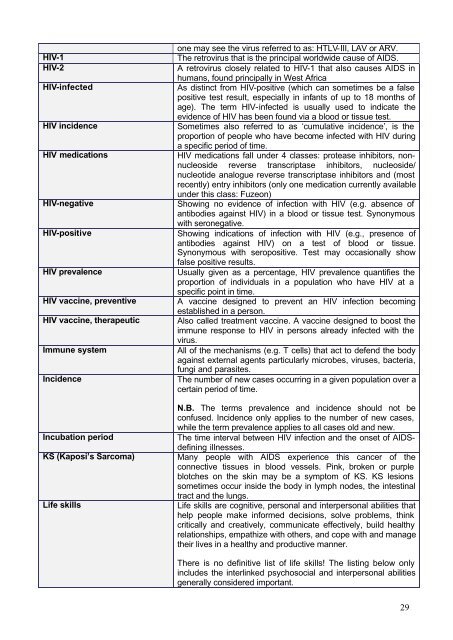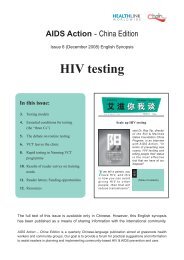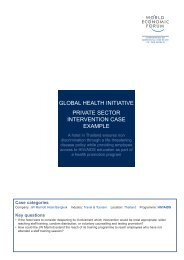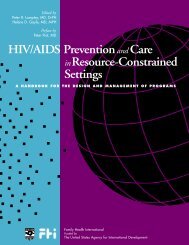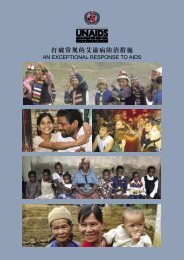What is HIV and AIDS?
What is HIV and AIDS?
What is HIV and AIDS?
Create successful ePaper yourself
Turn your PDF publications into a flip-book with our unique Google optimized e-Paper software.
one may see the virus referred to as: HTLV-III, LAV or ARV.<br />
<strong>HIV</strong>-1 The retrovirus that <strong>is</strong> the principal worldwide cause of <strong>AIDS</strong>.<br />
<strong>HIV</strong>-2 A retrovirus closely related to <strong>HIV</strong>-1 that also causes <strong>AIDS</strong> in<br />
humans, found principally in West Africa<br />
<strong>HIV</strong>-infected As d<strong>is</strong>tinct from <strong>HIV</strong>-positive (which can sometimes be a false<br />
positive test result, especially in infants of up to 18 months of<br />
age). The term <strong>HIV</strong>-infected <strong>is</strong> usually used to indicate the<br />
evidence of <strong>HIV</strong> has been found via a blood or t<strong>is</strong>sue test.<br />
<strong>HIV</strong> incidence Sometimes also referred to as ‘cumulative incidence’, <strong>is</strong> the<br />
proportion of people who have become infected with <strong>HIV</strong> during<br />
a specific period of time.<br />
<strong>HIV</strong> medications <strong>HIV</strong> medications fall under 4 classes: protease inhibitors, nonnucleoside<br />
reverse transcriptase inhibitors, nucleoside/<br />
nucleotide analogue reverse transcriptase inhibitors <strong>and</strong> (most<br />
recently) entry inhibitors (only one medication currently available<br />
under th<strong>is</strong> class: Fuzeon)<br />
<strong>HIV</strong>-negative Showing no evidence of infection with <strong>HIV</strong> (e.g. absence of<br />
antibodies against <strong>HIV</strong>) in a blood or t<strong>is</strong>sue test. Synonymous<br />
with seronegative.<br />
<strong>HIV</strong>-positive Showing indications of infection with <strong>HIV</strong> (e.g., presence of<br />
antibodies against <strong>HIV</strong>) on a test of blood or t<strong>is</strong>sue.<br />
Synonymous with seropositive. Test may occasionally show<br />
false positive results.<br />
<strong>HIV</strong> prevalence Usually given as a percentage, <strong>HIV</strong> prevalence quantifies the<br />
proportion of individuals in a population who have <strong>HIV</strong> at a<br />
specific point in time.<br />
<strong>HIV</strong> vaccine, preventive A vaccine designed to prevent an <strong>HIV</strong> infection becoming<br />
establ<strong>is</strong>hed in a person.<br />
<strong>HIV</strong> vaccine, therapeutic Also called treatment vaccine. A vaccine designed to boost the<br />
immune response to <strong>HIV</strong> in persons already infected with the<br />
virus.<br />
Immune system All of the mechan<strong>is</strong>ms (e.g. T cells) that act to defend the body<br />
against external agents particularly microbes, viruses, bacteria,<br />
fungi <strong>and</strong> parasites.<br />
Incidence The number of new cases occurring in a given population over a<br />
certain period of time.<br />
N.B. The terms prevalence <strong>and</strong> incidence should not be<br />
confused. Incidence only applies to the number of new cases,<br />
while the term prevalence applies to all cases old <strong>and</strong> new.<br />
Incubation period The time interval between <strong>HIV</strong> infection <strong>and</strong> the onset of <strong>AIDS</strong>defining<br />
illnesses.<br />
KS (Kaposi’s Sarcoma) Many people with <strong>AIDS</strong> experience th<strong>is</strong> cancer of the<br />
connective t<strong>is</strong>sues in blood vessels. Pink, broken or purple<br />
blotches on the skin may be a symptom of KS. KS lesions<br />
sometimes occur inside the body in lymph nodes, the intestinal<br />
tract <strong>and</strong> the lungs.<br />
Life skills Life skills are cognitive, personal <strong>and</strong> interpersonal abilities that<br />
help people make informed dec<strong>is</strong>ions, solve problems, think<br />
critically <strong>and</strong> creatively, communicate effectively, build healthy<br />
relationships, empathize with others, <strong>and</strong> cope with <strong>and</strong> manage<br />
their lives in a healthy <strong>and</strong> productive manner.<br />
There <strong>is</strong> no definitive l<strong>is</strong>t of life skills! The l<strong>is</strong>ting below only<br />
includes the interlinked psychosocial <strong>and</strong> interpersonal abilities<br />
generally considered important.<br />
29


